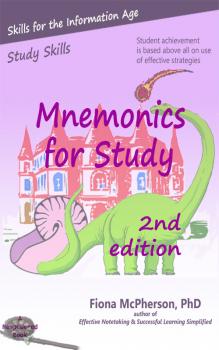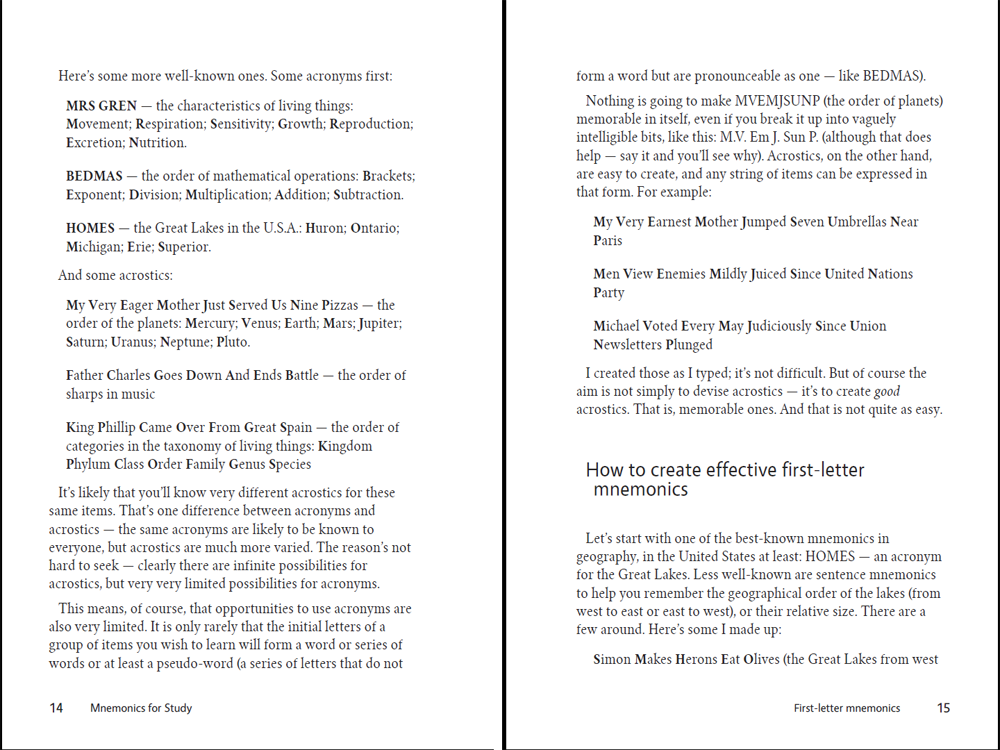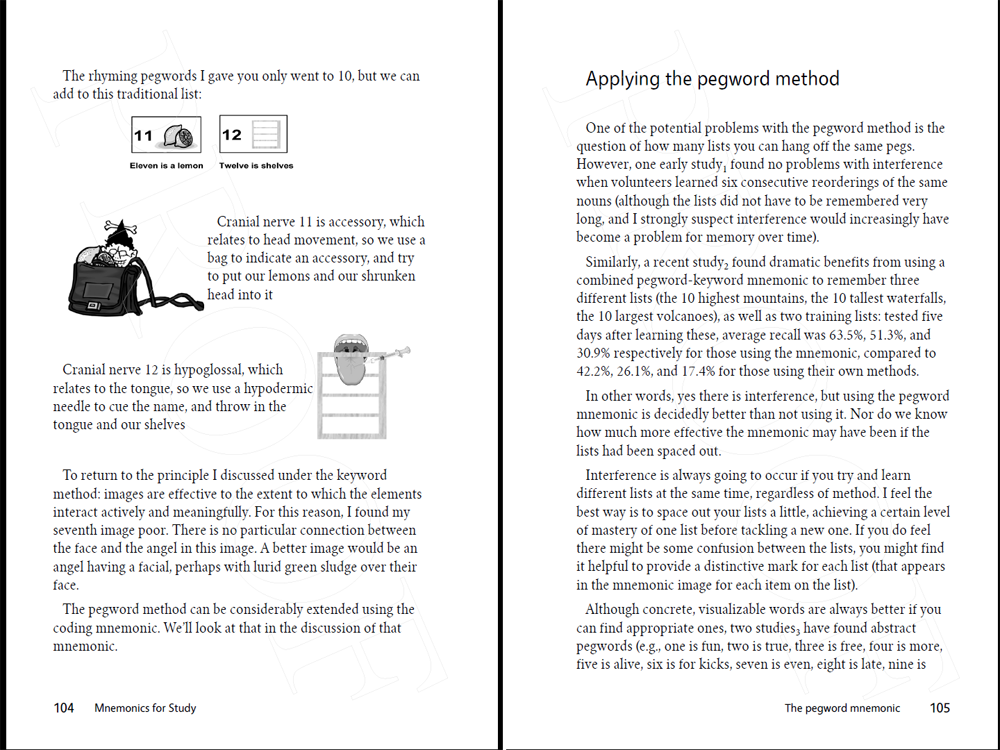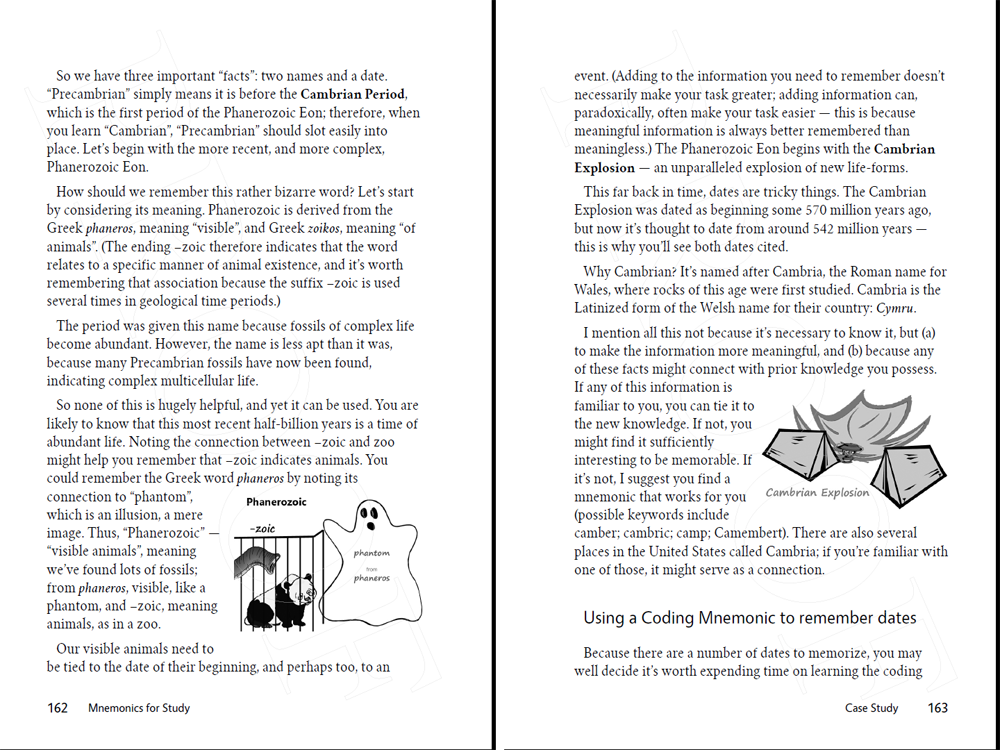This 2nd edition includes multi-choice chapter reviews, extra images, and a very detailed step-by-step case study showing how to use mnemonics to learn the Geological Time Scale.
Being a successful student is far more about being a smart user of effective strategies than about being ‘smart’. In fact it is possible to predict how well a student will do simply on the basis of their use of study strategies.
This book is a companion to the book on taking notes, although neither requires you to have read the other. Whereas the book on note-taking encompasses many study skills, including those of selection, organization, and comprehension, this book focuses solely on strategies for memorizing.
Mnemonics is one class of study strategy that is of proven effectiveness, but (like only too many effective strategies!) is used far too little. Despite many studies showing the effectiveness of mnemonic strategies, they remain the least frequently used formal memory aid used by students.
Perhaps the main reason for this is that their effectiveness is not intuitively obvious — truly, no one really believes that these 'tricks' can so remarkably improve memory until they try them for themselves.
But while mnemonics do not help you understand your material, they do help you remember those many details you need to achieve expertise in a topic — details such as the names of things, technical words, lists of principles.
Moreover, mnemonics can help you remember tags or labels that allow you to access clusters of meaningful information — for example, headings of a speech or main points for exam essays. For both these reasons, mnemonics are a valuable assistance to building up expertise in a subject, as well as in helping you 'cram' for an exam.
This concise book covers
- acronyms & acrostics
- rhythm & rhyme
- keyword strategies (including the face-name association method)
- the story method
- the loci or journey method
- the pegword method
- the link method
- coding mnemonics
While you can find basic information on these various mnemonic strategies in many books and websites, Mnemonics for Study goes far beyond the same tired descriptions, using the latest research to explain exactly how these strategies work and are best used.
The hardest part of permanently improving your memory is changing your habits and becoming an effective user of effective strategies. The best way to do this, research has shown, is through understanding how different strategies work, and when and how to use them. Through examples and exercises, that is what this book aims to teach you.
1. INTRODUCTION TO MNEMONICS
What are mnemonics and what are they good for?
Why are mnemonics effective?
About imagery
- Individual differences
- Using imagery
Review
PART I SIMPLE VERBAL MNEMONICS
2. FIRST LETTER MNEMONICS
The two types of first-letter mnemonics
How to create effective first-letter mnemonics
Problems with first-letter mnemonics
When first-letter mnemonics are a good strategy to use, and when they’re not
Review
3. RHYTHM & RHYME
Some familiar mnemonic jingles
Singing to remember
Spoken rhythm
Review
PART II KEYWORD STRATEGIES
4. THE KEYWORD METHOD
Some examples to practice
Creating good keywords
How effective is the keyword method?
- Limitations of the keyword method
- Remembering for the long term
- Comparing the keyword mnemonic to other strategies
Tasks for which the keyword method is useful
Using the keyword mnemonic to remember gender
Non-European languages
Review
5. EXTENSIONS OF THE KEYWORD METHOD
More than words
Applying the keyword method to text
The face-name mnemonic
- Applying the face-name mnemonic to art & artists
- Applying the face-name mnemonic to animals
- Extending the mnemonic to taxonomic & attribute information
Review
PART III LIST MNEMONICS
6. THE STORY METHOD
Examples
- Remembering word lists
- Remembering text
Pros & cons of the story method
Review
7. THE PLACE METHOD
Using the place method
- Some advice from antiquity
When to use the place method
Review
8. THE PEGWORD MNEMONIC
Applying the pegword method
Review
9. THE LINK METHOD
Effectiveness of the link method
Review
PART IV ADVANCED MNEMONICS
10. CODING MNEMONICS
A system for remembering numbers
Extending the coding mnemonic with other mnemonics
- Practical uses for coding mnemonics
- Dealing with decimals
Retrieval
Other languages may work better!
Using the coding system to extend the pegword mnemonic
Review
11. MASTERING MNEMONICS
What mnemonics are good for
- Assessing the text and the task
Choosing the right strategy for the task
Choosing the strategies that are right for you
Successful strategies need practice
Review
12. CASE STUDY
Memorizing new words, lists and dates
- Acronyms
- Looking for meaning
Chunking your information
Using a Coding Mnemonic to remember dates
More chunking
- Visuals always help
One era at a time
- Paleozoic Era
- Time to review
- Review 12.1
- The Mesozoic Era
- Review 12.2
- Cenozoic Era
- Review 12.3
- Review 12.4
- Precambrian
- The big picture
- Review 12.5
ANSWERS
REFERENCES
Formats: Paperback, E-book (pdf, mobi, ePUB, Kindle)
Size: 247 pages
Publisher: Wayz Press (March, 2018)
ISBN:
978-1-927166-42-0 (paperback)
978-1-927166-45-1 (pdf)
978-1-927166-43-7 (mobi)
978-1-927166-44-4 (ePub)








